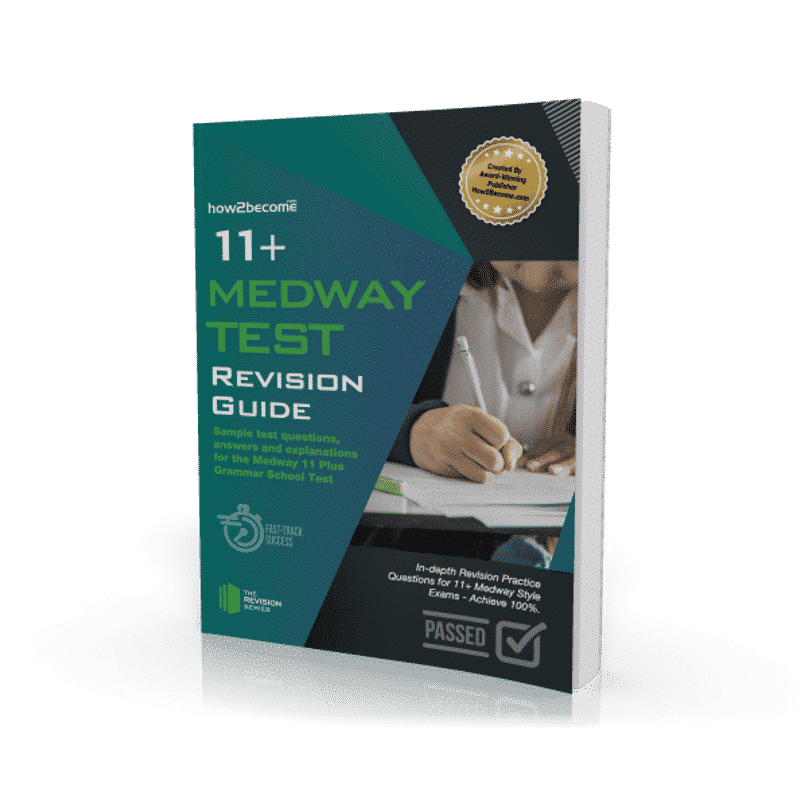WHAT IS THE MEDWAY ELEVEN PLUS?
In order for a student to join a Medway grammar school, they will need to pass the Medway 11+. The Medway 11+ is a separate examination to the Kent Test, and the two are not the same. If you currently live outside of Medway, but would like your child to join a Medway grammar school, then they will need to be registered for the Medway Test.
The Medway Test consists of three sections in total:
• Maths
• Verbal Reasoning
• Extended Writing
The format of the test can differ between years, so it’s important to research and ensure that you are preparing for the correct yearly version of the test.
In this blog, we’ll focus specifically on the Maths element of the Medway Eleven Plus!
Medway 11+ Maths
The Maths section of the Medway 11+ is designed to test your understanding of basic calculations, numbers, percentages, graphs, ratios, and other such mathematical constructs. All of the questions will be multiple choice in nature, and you will not be permitted to use a calculator.
There are a wide variety of questions which you might encounter during this exam, and they include:

Percentage Questions
These types of questions focus on your ability to understand percentages and how they work. There are lots of different factors to percentage questions, and said questions can ask you to work out a number of different things. You might be asked to calculate:
- A percentage increase.
- A percentage decrease.
- Basic percentage calculations. For example, 50% of 100.
- A monetary discount. For example, 20% discount on a pair of shoes that cost £40.
- The percentage chance of an event/something occurring.
To work out percentages, divide the whole number by 100 and then multiply the percentage you want to find.
Example Question
There are 40 pupils in a classroom. 25% of these pupils fail their test, and will need to resit the test. Upon resitting, another 30% of these pupils fail for a second time. How many people failed the test at the second attempt?
- 3
- 9
- 5
- 7
Answer
Answer =3
Explanation = 25% of 40 = 10 pupils who failed the test the first time round.
30% of this 10 pupils failed the second time. 30% of 10 = 3.
Therefore, 3 pupils failed their second attempt.

Mean, Median, Mode, Range
These types of questions are very common, and focus on groups of numbers. As a refresh, here is how to work out all of the above:
- Mean/Average – add all of the numbers together and then divide by the amount of numbers.
For example: if we had the values of 20, 21, 22, 23, and 24, to find the average we would add all the numbers together – 20 + 21 + 22 + 23 + 24 = 110, and then divide by the total number of values. So, 110 ÷ 5 = 22. The average value here is 22.
- Median – the middle value, when all the numbers are placed in consecutive, ascending order.
For example: if we had the values of 20, 29, 24, 27, 32, 45, and 30, we would first need to place these numbers in consecutive order – 20, 24, 27, 29, 30, 32,45.
The middle number (or median) would be 29, since there are 7 numbers, and there are three on each side of this value.
- Mode – The most frequently occurring number.
For example, if we had the values of 24, 25, 87, 32, 46, 56, and 46, then the mode would be 46 – as this is the most frequently occurring number.
- Range – the highest value minus the lowest value.
For example, if we had the values of 89, 24, 56, 12, 4, and 19, then we would subtract 4 from 89 to find the range, which would be 85.
Usually, you’ll be given a set of data, and then will be asked to work out the above using said data.
Example Question
Sophie has recently come into a great deal of money, and has decided to go shopping. Over the course of the week, Sophie goes shopping every day, and purchases the following items:
- Monday – £25.00 on a dress
- Tuesday – £62.00 on a pair of shoes
- Wednesday – £84.00 on a handbag
- Thursday – £65.00 on a t-shirt
- Friday – £50.00 on a pair of boots
What was Sophie’s average spend per day?
- £58.75
- £64.50
- £68.70
- £57.20
Answer
Answer = £57.20
Explanation = To work this out, first of all add the total spending.
So, £25 + £62 + £84 + £65 + £50 = £286.
£286 ÷ 5 (5 days) = £57.20
Ratios
Ratios are another very common type of question in the exam, and you can expect to answer a number of questions based on this.
You’ll normally be asked to work out a value based on a ratio. So, you’ll be given a total figure, let’s say 1,000 litres, and then told that this is divided into oil and water (or another such substance), in a ratio – for example, 20:30. This means that for every 20 litres of oil, there are 30 litres of water. It is important to remember that whichever element is mentioned first will be represented on the left-hand side of the ratio. You then must work out how many litres there are of each substance, using the ratio.
Example Question
Moira is a florist. In her shop today, she has roses, freesias, and sunflowers. Today, business is bad. Moira only sells 4 roses, and none of the other plants. She now has 180 plants in her shop, in the ratio 4:4:12.
How many sunflowers does Moira have in her shop?
- 140
- 78
- 70
- 108
Answer
Answer = 108.
Explanation = To work this out, first of all add up the ratios. 4 + 4 + 12 = 20. Then, work out 180 divided by 20 = 9. Multiply the 12 by 9, to get 108 sunflowers.
Medway Eleven Plus Revision Guide
If you’re looking for more tips on the Maths element of the Medway Eleven Plus, in addition to English, and Extended Writing, make sure you pick up a copy of our fantastic guide. This book is jam-packed with all the knowledge and information on EVERY element of the Medway Eleven Plus, and guarantees to improve your child’s chance of success!


